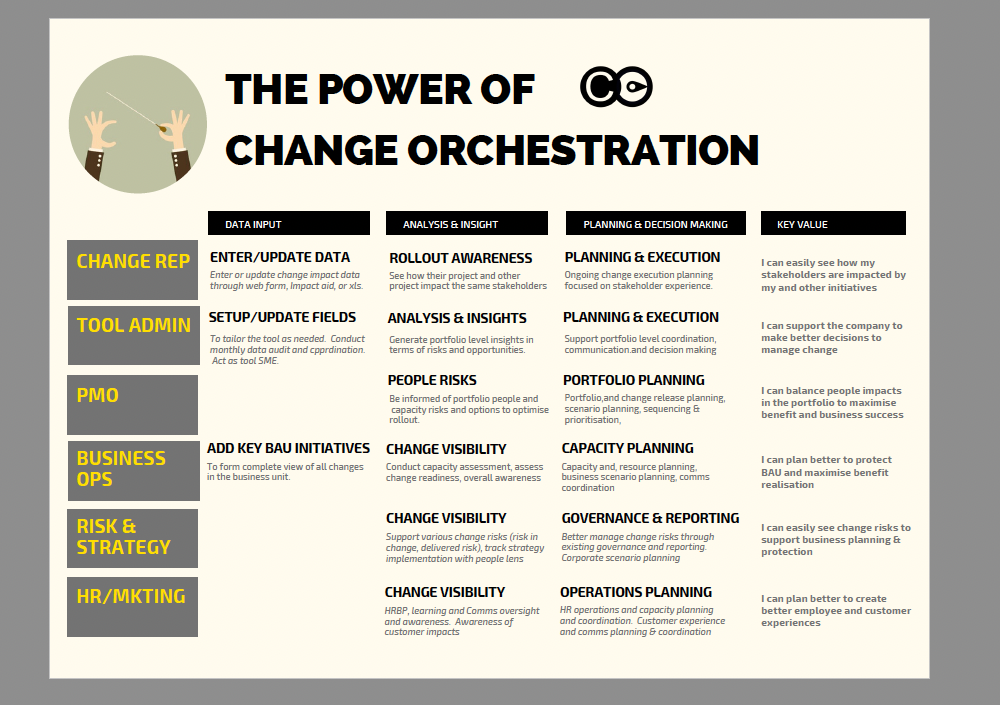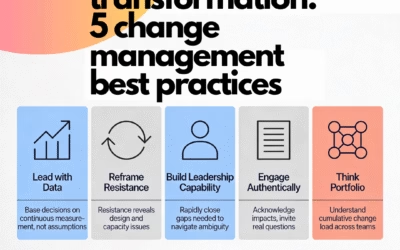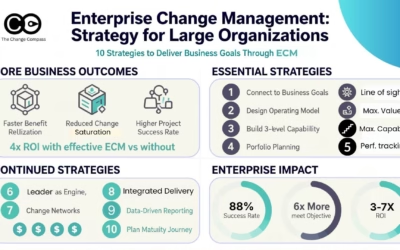Most of what you read about change is only concerned with the various stakeholders within one singular change journey. This ranges from various change methodologies to techniques and the experience of change, including the ‘change curve’ that dips after go-live and then slowly rises up. Is this really the only value of change? Are we only adding value one change at a time?
In managing change at a program or portfolio level, we are overseeing multiple changes. The focus is no longer focusing on the tactics and execution of individual changes. Instead, the focus is on how to get the maximum organisational impact to maximise value and realise maximum benefits. This is in done in conjunction with protecting the business-as-usual activities and overall business performance.
The ultimate value of change management is in orchestrating change across the organisation. This is not just in terms of change programs, but orchestrating how other departments and business units handle change. Change does not just happen in a project setting, since it is also led by various departments as a part of general business improvement.
Different corporate functions have a role to play in change orchestration.
This role is not just for the PMO, or the change practitioner.
And what is change orchestration?
It is the act and the ability to effectively steer the flow of change through the organisation in a way that balances the need for the pace and intensity of change, with the pace of BAU and overall business performance.
To effectively orchestrate change the conductor needs to clearly see and know what each change initiative should be doing in the overall system.
– Is each initiative acting in harmony with other changes? Or are there conflicting messages?
– Is the pace of each change the right pace for the organisation? Or is it too fast/slow?
– Does the runway need to cleared for big strategic initiatives to land? When and where?
– How is each initiative evolving in their agile development? What is the change outcome becoming?
Corporate functions such as PMO, Operations, Risk, Strategy, HR and Marketing could all have a role to play in helping to orchestrate change for the company.
How?
By seeing what the change initiatives are and how they’re developing.
By sharing the data on the changes they’re driving, whether they’re impacting employees, customers or partners.
By participating in joint planning and governance of the overall portfolio of changes.
By sharing risks of potential execution on business performance.
By analysing the data and sharing how there can be opportunities to better create and improve employee or customer experiences.
It is up to change practitioners to educate and involve various corporate functions to create this synergy.
With the active involvement of various corporate functions, the act of change orchestration can be more harmonised, holistic and in synch.
This ultimately means optimising business performance and maximising benefit realisation across the whole change portfolio of initiatives.
Download our table to understand more about how to influence and orchestrate change across the organisation using The Change Compass. The power is in using data to drive visibility, clarity, and understanding of how change impacts not just our employees, but also organisational partners, and customers. In this way, business units such as Strategy, Marketing, HR, Corporate Affairs, and Operations all have a role to play in orchestrating change.
Click here to download our table about change orchestration.






